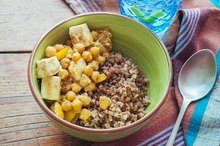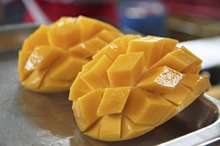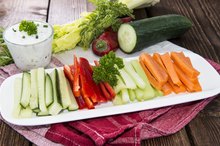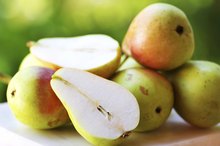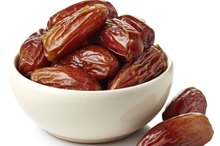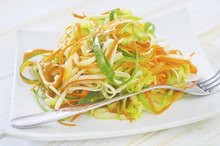What does fact checked mean?
At Healthfully, we strive to deliver objective content that is accurate and up-to-date. Our team periodically reviews articles in order to ensure content quality. The sources cited below consist of evidence from peer-reviewed journals, prominent medical organizations, academic associations, and government data.
- Medline Plus: Fiber
- Mayo Clinic.com: Nutrition and Healthy Eating: Dietary Fiber: Essential for a Healthy Diet
The information contained on this site is for informational purposes only, and should not be used as a substitute for the advice of a professional health care provider. Please check with the appropriate physician regarding health questions and concerns. Although we strive to deliver accurate and up-to-date information, no guarantee to that effect is made.
List of Roughage Foods
Roughage is another name for dietary fiber, which occurs naturally in fruits, vegetables and grains. A diet high in dietary fiber can have many health benefits, including aiding digestion, reducing constipation and controlling weight. Dietary fiber is also used to treat a variety of conditions, such as heart disease, diverticulosis and diabetes. According to the 2005 Dietary Guidelines for Americans, you should consume 14 grams of fiber for every 1,000 calories in your diet. If you eat 2,000 calories a day, you should aim for 28 grams of fiber.
Fruit
Fruit boasts a high content of dietary fiber. Since fiber is often concentrated in the peel, not eating them will reduce fiber content. A large apple provides about 3.3 grams of fiber; a banana, approximately 3.1 grams; a cup of blackberries, 7.6 grams; a small orange, 3.1 grams; and a cup of raisins, 5.4 grams.
Vegetables
The Carbohydrates in Garbanzo Beans
Learn More
Vegetables also have a high dietary fiber content. A cup of baked beans has 10.4 grams; a cup of lentils, 15.6 grams; and a cup of winter squash, 5.7 grams. A half of a sweet potato provides 3.9 grams; a cup of split peas, 16.3 grams; and a cup of carrots, 3.1 grams.
- Vegetables also have a high dietary fiber content.
- A half of a sweet potato provides 3.9 grams; a cup of split peas, 16.3 grams; and a cup of carrots, 3.1 grams.
Grains
Grains, including bread and cereal, also are good sources of dietary fiber. A slice of whole grain bread provides 1.7 grams; a cup of oatmeal, 4 grams; and a cup of brown rice, 3.5 grams. Brown rice has more fiber than white rice, and wheat bread has more fiber than white bread.
Nuts
Mangoes & Fiber
Learn More
Nuts also provide dietary fiber 2. A serving of 24 almonds provides approximately 3.3 grams; 28 peanuts, about 2.3 grams; and 14 English walnut halves, about 1.9 grams.
Related Articles
References
- Medline Plus: Fiber
- Mayo Clinic.com: Nutrition and Healthy Eating: Dietary Fiber: Essential for a Healthy Diet
- Full article: Changes in dietary fiber intake in mice reveal associations between colonic mucin O-glycosylation and specific gut bacteria
- Fiber
- Fiber
- Closing America’s Fiber Intake Gap
- Meta-Analysis of Usefulness of Psyllium Fiber as Adjuvant Antilipid Therapy to Enhance Cholesterol Lowering Efficacy of Statins - ScienceDirect
- Fiber
- Fiber
- New Horizons for the Study of Dietary Fiber and Health: A Review | SpringerLink
- FoodData Central
- Error
- FoodData Central
- Error
- None
- FoodData Central
- Error
- None
- FoodData Central
- Acute Effects of Nitrate-Rich Beetroot Juice on Blood Pressure, Hemostasis and Vascular Inflammation Markers in Healthy Older Adults: A Randomized, Placebo-Controlled Crossover Study - PubMed
- FoodData Central
- None
- FoodData Central
- None
- FoodData Central
- FoodData Central
- FoodData Central
- FoodData Central
- None
- FoodData Central
- Error
- Error
- FoodData Central
- Error
- FoodData Central
- FoodData Central
- Effect of Oat β-Glucan Intake on Glycaemic Control and Insulin Sensitivity of Diabetic Patients: A Meta-Analysis of Randomized Controlled Trials - PubMed
- Error
- FoodData Central
- FoodData Central
- FoodData Central
- None
- FoodData Central
- FoodData Central
- None
- None
- FoodData Central
- None
Writer Bio
Rebekah Richards is a professional writer with work published in the "Atlanta Journal-Constitution," "Brandeis University Law Journal" and online at tolerance.org. She graduated magna cum laude from Brandeis University with bachelor's degrees in creative writing, English/American literature and international studies. Richards earned a master's degree at Carnegie Mellon University.
